As Women’s History Month winds down, we recognize the innovation, achievement, and leadership of women across the energy efficiency industry. Here at the VAEEC, the work women do to advance energy efficiency is obvious – we’re an all women team, with several additional women serving on our Board of Directors and in Executive Leadership. To celebrate, we are recognizing three VAEEC members who lead the pack of women-owned businesses.
Raye Elliott is the Co-Founder and Executive Director of FLIPP Inc a 501c3 nonprofit headquartered in Dillwyn, VA that exists to reduce employment barriers for disadvantaged populations and to empower low-income communities with renewable energy training. Ms. Elliott serves on the board of the Virginia Renewable Energy Alliance (VA-REA), and more notably skyrocketed FLIPP Inc’s annual revenue from under $50,000 to more than $2.3 million within ten months of being appointed as the Executive Director in 2022. Raye holds a master’s degree in information technology, has a background in Hydropower with the US Army Corps of Engineers, and in Construction and Federal Government Contracting with the Department of Defense. Raye recently designed a renewable energy worker-centered sector strategy that was grant funded in 2023 by the USDOL-ETA just shy of $2 million. She has led FLIPP Inc to be the 2023 recipients of the C3 “Energy Equity Award” & the United States Green Building Council-Virginia Chapter’s 2023 “Community Impact Organization of the Year Award”. Raye believes in an “equity in energy” industry strategy, being a great bridge for the barrier ridden, returning back into the workforce and the un-employed individual that needs meaningful employment within a rapidly growing industry.
Jennifer Jesse is the visionary force behind Quick AC Quote (QUACQ), a distinguished SWAM designated Class A contractor licensed in Virginia and West Virginia, where she serves as both founder and Chief Financial Officer. Under Jennifer’s dynamic leadership, QUACQ has earned a sterling reputation for excellence, specializing in large-scale multi-family HVAC replacement projects with a workforce of 20 dedicated employees. With a remarkable capacity to replace 30-40 heat pump systems weekly, QUACQ also extends its expertise to single-family homes, offering comprehensive weatherization services and addressing diverse heating and cooling needs with unparalleled precision. With over 18 years of dedicated service as a Registered Nurse and a further 9 years as a Realtor, Jennifer’s unwavering commitment to helping others has remained steadfast. Whether providing compassionate care to oncology patients, facilitating significant home purchases, or pioneering energy-efficient solutions since 2019, Jennifer’s passion for making a positive impact shines through in every endeavor. A lifelong learner, Jennifer’s love of acquiring new skills and knowledge fuels her success, a trait she attributes to her consistent dedication to growth and innovation.
Driven by a constant commitment to excellence and sustainability, Jennifer continues to lead QUACQ with distinction, empowering her team to reach new heights of success. Through strategic initiatives aimed at employment, education, and certification, Jennifer ensures QUACQ remains at the forefront of the industry. With ambitious plans to expand into multiple East Coast states by the end of 2024, Jennifer’s vision for QUACQ transcends mere business goals; it’s about building a better, more sustainable future for generations to come.
Sandra Leibowitz is the Founder and Owner of Sustainable Design Consulting, LLC (SDC), operating from offices in Richmond, Virginia and Washington, DC. Prior to founding SDC in 2002, Sandra served as Sustainable Design Specialist for three Washington, DC-area architecture and consulting firms, after earning a Master of Architecture degree from the University of Oregon.
Sandra draws from over 30 years of advanced experience with hundreds of sustainable design projects and dozens of organizational programs to serve institutions, building owners, design, construction and property management professionals with expert green building consulting and process management. She leads SDC’s team of experienced and credentialed professionals integrating sustainable design, construction, operations, maintenance, measurement, and reporting concepts into projects of varying size and complexity.
When and why did you start/buy this business?
Sandra Leibowitz: I founded Sustainable Design Consulting (SDC) in 2002. By that point, I had been in the DC-area for some six years, working for three architecture and consulting firms. At that time and in that place, the ideal firm I would have wanted to work for didn’t really exist, so I concluded that I had to either make it myself or just go and join another architecture firm, which would have been the easier path, by far.
Raye Elliott: In September 2020, FLIPP Inc was birthed by myself and my cousin AJ; we started out simply wanting to change mindsets and ended up transforming lives. Our inspiration for the company’s mission was a combination of personal passion and wanting to provide high-quality progressive career avenues for all. The ongoing fight the Historic Union Hill community had to prevent the Dominion Energy ACP from polluting our community was definitely a catalyst event (where we lived our entire childhood lives at), the stagnation observed of the Buckingham County Economic Development and the lack of opportunity in the area.
Jennifer Jesse: Several years ago, I embarked on the journey of founding a HVAC company in Virginia. Our inception as an HVAC enterprise stemmed from a deep-seated desire to aid individuals in need, aiming to provide them with enhanced energy-efficient heating and cooling solutions for their residences. As our commitment to serving our community intensified, our company evolved to encompass a broader spectrum of energy efficiency weatherization measures, meticulously designed to not only optimize home comfort but also alleviate the financial burden associated with homeownership.
What are some ways women can access leadership roles in EE?
Jennifer Jesse: Women can access leadership roles in the energy efficiency (EE) industry through a combination of education, experience, networking, and mentorship. Seeking out opportunities for hands-on experience, volunteering, and professional development can help build skills and credibility. Networking with other women in the industry, joining professional organizations, and seeking out mentors can also provide valuable support and guidance on the path to leadership.
Sandra Leibowitz: You can do what I did: launch your own consultancy, but starting and maintaining a small business can be very challenging in and of itself. These days, there are many existing opportunities in EE policy and practice, both in the public and private sectors. When climbing one of those ladders toward leadership, becoming known externally as a subject matter expert, professional advocate and/or community leader can be very helpful. Of course, some leadership roles are more about organizational management, so if that’s a skillset of yours, as it is among mine, then show your worth by taking on higher and higher levels of internal responsibility.
Raye Elliott: Creating an environment “from the top down” within an organization that encourages women obtaining leadership roles, making gender diversification a NECESSITY and not a PERK, awareness of these roles and proper engagement.
What advice would you give women who are trying to enter the industry?
Raye Elliott: Be persistent, gain experience, get credentialed and master the art of networking.
Jennifer Jesse: My advice to women entering the energy efficiency industry is to be confident in your abilities and passionate about your mission. Don’t be afraid to pursue opportunities, take on challenges, and advocate for yourself. Seek out like minded individuals who can offer support and guidance along the way. Remember that your unique perspective and experiences are valuable assets that can contribute to the industry’s success.
Sandra Leibowitz: Spend at least a few months checking out the types of organizations that you think you might want to work for and read the job descriptions that are offered. Join professional and/or local community organizations and pour some of your time and energy (don’t overdo it!) into initiatives that excite you. Send out resumes to the employers that interest you and request informational interviews, because you never know when the perfect opportunity may open up – it’s so helpful to employers to already have a pipeline of promising candidates at their fingertips when an opening occurs. And don’t forget to keep your LinkedIn profile updated!
What barriers and opportunities do you perceive for women in EE?
Jennifer Jesse: Women in the energy efficiency industry face both barriers and opportunities. Some barriers include gender bias, lack of representation in leadership roles, and limited access to resources and opportunities. However, there are also opportunities for women to excel in the industry, such as the growing demand for sustainable solutions, the emphasis on diversity and inclusion, and the increasing recognition of the importance of women’s contributions. By advocating for gender equity, supporting one another, and leveraging our strengths, we can overcome barriers and create a more inclusive and equitable industry.
Raye Elliott: Barriers for women in EE I’ve observed are 1. stereotypes as to what jobs women ‘should’ do, 2. systemic inequality of opportunity and 3. Just being in a “male-dominated” industry is deemed as a danger to the men because we are a minority and viable competition.
Opportunities are 1. We are many times under-estimated and are able to easily surpass our male counterparts, 2. Where there’s threats there are always opportunities – due to the high disparity there’s an increased emphasis on women in leadership roles and 3. I’ve begun mentoring other women to enter into the renewable energy and energy efficiency sector. If we support, mentor, create avenues for advancement and empower one another, we help ease the transition together.
Sandra Leibowitz: Depending on the specific job and work environment, EE can still be very male-dominated. That’s really not true of sustainable design or green building anymore, so in this case I’m speaking less from direct experience than I am from an observer’s viewpoint. Also, employers know that women tend to be adept at organizing people, programs, and initiatives – which can be a double-edged sword. On the one hand, doing what comes naturally can help raise your profile and get you a seat at the table. On the other hand, women shouldn’t step into or stay in roles just because men won’t – or still assume that it’s ‘women’s work’.
Tell me a little about your background. How did you get into the EE industry?
Raye Elliott: I have a background in hydropower and solar workforce development; renewable energy placed me on a path to learning how integral energy efficiency is and its importance. I had my in-depth exposure with energy efficiency when I worked with the Department of Defense as a construction contracting official and our armory renovations as well as our newly constructed Joint Forces Headquarters buildings had to be LEED certified. I was surprised and fascinated with how much work and the consideration that went into ensuring a “Green Building” was achieved by focusing on the holistic approach to minimize its environmental impact.
Jennifer Jesse: With a background of being a Registered Nurse and Realtor and an understanding of business, I was fortunate enough to step into a platform inside the EE industry that allows me to keep assisting those in need. It has always been my desire to help and extend out a hand when possible to ensure those who are in need are heard and taken care of. Energy Efficiency has allowed me to not only help people but also help this wonderful planet we live on. It has felt like a true blessing to do something so meaningful.
Sandra Leibowitz: I started in this direction – which I guess was originally called ‘environmental architecture’ – way back in 1992 as I was graduating college, where unfortunately I learned little about all this at that time. I did so because I loved architecture, yet considered myself an environmentalist, so put it together for myself by choosing architecture as my environmental career. After grad school at the University of Oregon, where I immersed myself in what we then called ‘ecological design’, I moved to DC, where we instead tended to call it ‘sustainable design’. Over several years working for others, I began what would become my ultimate professional career as a ‘green building’ consultant / consulting firm leader. Living in Richmond for many years further expanded my community into the Central Virginia region.
What is something you wish people of other genders knew about your experiences?
Sandra Leibowitz: Women leaders seem to be expected to make everyone happy all the time. Besides being impossible generally, it’s both unrealistic and unfair to think that others’ happiness is under our control. Furthermore, we don’t tend to burden male leaders with that expectation.
Raye Elliott: It’s extremely hard breaking into an industry that is both white-washed and male dominated. Folks that aren’t clear on my experience and contributions (and those that are clear), have judged, discriminated, and tested me two or three times more than the guys. I personally have been held to a higher standard and had to prove myself more than men I am acquainted with, within the EE and renewable sectors.
Jennifer Jesse: I wish people understood the resilience, determination, and perseverance required to navigate these challenges and succeed in leadership positions as a woman. It’s not just about breaking through the glass ceiling; it’s about constantly pushing against barriers, advocating for oneself and others, and overcoming stereotypes and biases that can undermine our credibility and contributions. Overall, I wish people of all genders would recognize the importance of supporting and empowering women in leadership roles, not just for the benefit of individual women but for the success and resilience of businesses and organizations as a whole.
What’s your favorite EE tip?
Raye Elliott: Turn off the lights when they’re not in use. This is approximately 12% of a usual residential utility bill.
Jennifer Jesse: My favorite EE tip would be to regularly maintain and tune up your HVAC system with the easiest being checking and replacing your filter regularly. Proper maintenance ensures that your heating and cooling equipment operates at peak efficiency, reducing your energy bills, improving comfort, and reducing your carbon footprint. Regular maintenance and smart usage practices are key to maximizing the efficiency and performance of your HVAC system.
Sandra Leibowitz: Bigger isn’t necessarily better – that can be said of buildings themselves, their equipment, and the organizations that own and occupy them. Take a ‘right-sizing’ approach to EE and life in general!
Throughout 2023, the VAEEC worked with our members to advance energy efficiency policies and programs in Virginia. Check out the graphic below to see our top 10 accomplishments. 2023 began the first year of our new, three-year strategic plan, which builds off of the tremendous progress we’ve made over the last several years. We are excited to begin the next chapter on solid ground with endless opportunities.
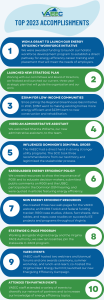
The Commonwealth’s energy efficiency community gathered on October 4th and 5th for the VAEEC’s annual Energy Efficiency Forum. Thank you to our sponsors, speakers, award winners, and attendees for making this event a great success!
Day one was fully virtual in an effort to make the event more accessible and to provide a diverse array of speakers from across the country. It consisted of a keynote address and four breakout sessions:
Keynote Address: Dr. Bob Holsworth is a Managing Partner at DecideSmart, a consulting firm that provides strategic solutions for complex challenges. Bringing decades of experience in the political sphere, he provided an analysis of Virginia’s election landscape and what that can mean for the Commonwealth’s clean energy future.
“Regardless of the election results, there will be a slate of new legislators. Education will be important.” – Dr. Bob Holsworth, DecideSmart
Technology: What’s New and What’s Next?: The panelists in this session discussed heat pumps and heat pump hot water heaters, demand response AI programs, and data center cooling technologies. The discussion helped to sift facts from fiction and suss out what the on-the-ground realities are, and what we can look forward to in the future. Speakers included Richard Anderson (Siemens), Millie Knowlton (CPower), Andrew Grigsby (Viridiant), and Adam Sledd (Dominion Energy Innovation Center, moderator).
“The question we try to answer is, how can we leverage technology to help humans?” – Richard Anderson, Siemens
Implementing Green Building Policies in a Dillon Rule State: As a Dillon Rule state, Virginia localities are limited as to what they can and cannot mandate. However, jurisdictions are finding creative ways to make progress happen in their communities. Join speakers from Arlington County and the City of Alexandria as they discuss their green building policies and programs, and how they have established minimum standards for new development and major renovations. This was an interactive session where audience members were encouraged to engage with speakers to learn how to implement their own green building policies. VAEEC Board member, Bill Eger (Arlington County), moderated the panel, which included Arlington County’s Paul Roman and the City of Alexandria’s Valerie Amor, and Robert Kerns.
“The idea of ‘business as usual’, ‘we’ve always done it this way’, is one of the biggest challenges in getting developers on board. We’ve got to embrace new ways of doing things to implement green building strategies.” – Valerie Amor, City of Alexandria
Rural Energy Efficiency: No Town Left Behind: According to the Department of Housing and Urban Development, 88% of Virginia is considered rural. However, this population is often overlooked in energy efficiency policy and programs. This panel focused on how to reach rural communities and what opportunities are available to them. Speakers included Adia Holland (U.S. Department of Agriculture), Lance Hostutler (Optimum Building Solutions LLC), Will Payne (Energy Delta SWVA), and VAEEC Board Vice Chair, Leigh Anne Ratliff (Trane Technologies, moderator).
Case Study Session: Green Building Certifications: Green buildings are environmentally responsible, resource-efficient, and create healthier, more comfortable spaces. Numerous certification systems exist to assess a building’s sustainability and designate it as a green building. This case study session was designed for attendees to benefit from shared knowledge and experience through presentations and audience Q&A. The certifications featured included EarthCraft, Zero-Energy Ready, and Pearl Certification for single-family homes, multifamily buildings, and whole communities. The session was moderated by VAEEC Board member, Bryna Dunn (Moseley Architects), and speakers consisted of Stephen Dareing (Viridiant), Jay Epstein (Healthy Communities), and Casey Murphy (Pearl Certification).
“I want to make low-performing homes the green avocado refrigerators of 2023.” – Casey Murphy, Pearl Certification
After the virtual day wrapped up, attendees had the opportunity to join one of two regional happy hours to further connect with other energy efficiency professionals. This was the first time we have offered a regional happy hour in conjunction with a virtual event. What a great way to spend 2023 #EnergyEfficiencyDay!
Attendees gathered in person for day two at the University of Richmond Jepson Alumni Center in Richmond. The day began with an opening presentation from Executive Director, Chelsea Harnish. Attendees were provided with updates on the organization’s 2023 accomplishments and our 2024 priorities, as well as an overview of the Commonwealth’s energy efficiency industry. The day also included a keynote address, a plenary panel, the eighth annual Virginia Energy Efficiency Leadership Awards ceremony, and an on-site reception.
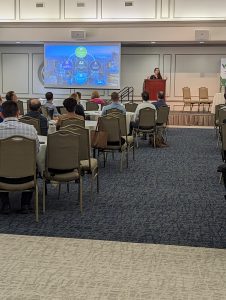 Keynote Address: Attendees were then treated to a keynote address from Dr. Karma Sawyer, Director of Electricity Infrastructure & Buildings (EI&B) Division at the Pacific Northwest National Laboratories (PNNL). In this role, Dr. Sawyer is responsible for shaping and managing a vision and strategy to ensure that PNNL addresses the U.S. Department of Energy’s most important energy efficiency, clean energy, and electricity infrastructure challenges. She discussed energy efficiency as it relates to cutting-edge research, building codes, market transformation, federal funding, and emerging technologies, with a specific focus on equity.
Keynote Address: Attendees were then treated to a keynote address from Dr. Karma Sawyer, Director of Electricity Infrastructure & Buildings (EI&B) Division at the Pacific Northwest National Laboratories (PNNL). In this role, Dr. Sawyer is responsible for shaping and managing a vision and strategy to ensure that PNNL addresses the U.S. Department of Energy’s most important energy efficiency, clean energy, and electricity infrastructure challenges. She discussed energy efficiency as it relates to cutting-edge research, building codes, market transformation, federal funding, and emerging technologies, with a specific focus on equity.
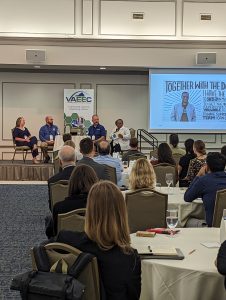 The Energy Efficiency Workforce Initiative: A Holistic Path to Workforce Development: After a break for networking and snacks, attendees came back together for the plenary session focused on the VAEEC’s Energy Efficiency Workforce Initiative. For the last two years, the VAEEC has been developing the EEWI to address Virginia’s growing workforce needs. This panel provided updates from staff and our expert partners as we build out each piece of the puzzle – recruitment, training, placement, and sustainable retention. Speakers included Laura Hanson (Tidewater Community College), Phil Hull (CHP Energy Solutions), Michael Flanagan (Quick AC Quote), Crystal McDonald (D.C. Sustainable Energy Utility), and Rebecca Hui (Virginia Energy Efficiency Council, moderator).
The Energy Efficiency Workforce Initiative: A Holistic Path to Workforce Development: After a break for networking and snacks, attendees came back together for the plenary session focused on the VAEEC’s Energy Efficiency Workforce Initiative. For the last two years, the VAEEC has been developing the EEWI to address Virginia’s growing workforce needs. This panel provided updates from staff and our expert partners as we build out each piece of the puzzle – recruitment, training, placement, and sustainable retention. Speakers included Laura Hanson (Tidewater Community College), Phil Hull (CHP Energy Solutions), Michael Flanagan (Quick AC Quote), Crystal McDonald (D.C. Sustainable Energy Utility), and Rebecca Hui (Virginia Energy Efficiency Council, moderator).
Energizing Efficiency Campaign & Virginia Energy Efficiency Leadership Awards Ceremony: Next, we had the honor of hosting our eighth annual Virginia Energy Efficiency Leadership Awards ceremony. We started off by highlighting the 18 submissions to our inaugural Energizing Efficiency Campaign. Case studies can be viewed for each of these participating projects or programs on our 2023 Energizing Efficiency Campaign page. From these 18 submissions, five were chosen by the VAEEC’s Education & Events Committee to receive a 2023 Virginia Energy Efficiency Leadership Award for their incredible energy efficiency contributions. For information on each winning project or program, visit our 2023 Awards page.
The event concluded with an on-site networking reception sponsored by Dominion Energy. It is always a pleasure to connect with many of our members and others in the industry face-to-face, and this was no exception.
Thank you to our sponsors, speakers, award winners, and event attendees for making this one of our best events to date. Click here to view photos of the event. Additional event information, including speaker biographies and sponsor features, can be found in the event program.
Event attendees will receive recordings for each of the four breakout sessions in the post-event email. Presentation PDFs can be viewed at the links above.
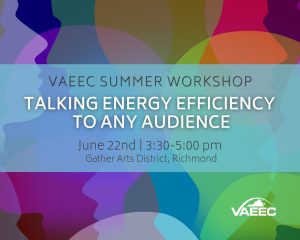 Last week, the VAEEC held our first-ever Summer Workshop, Talking Energy Efficiency to Any Audience. The idea originated through staff conversations about how do you explain energy efficiency to elementary students at a career day or to our parents when they are concerned about rising utility bills.
Last week, the VAEEC held our first-ever Summer Workshop, Talking Energy Efficiency to Any Audience. The idea originated through staff conversations about how do you explain energy efficiency to elementary students at a career day or to our parents when they are concerned about rising utility bills.
During the event, attendees heard from three experts on how to discuss energy efficiency with your neighbors, business owners, contractors, and kids. Facilitators included:
- Corey Argentino, EarthRight,
- Michael Flanagan, Quick AC Quote, and,
- Josh Woodruff, Franklin Energy.
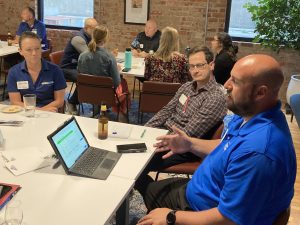 Afterward, we self-selected into small groups to work with those facilitators on our own pitch. Key takeaways included:
Afterward, we self-selected into small groups to work with those facilitators on our own pitch. Key takeaways included:
- Energy Efficiency is frequently confused with solar. Provide examples of efficiency measures (insulation, LED lighting, system controls, etc.) to distinguish the difference between the two, and explain the importance of efficiency before renewables (the cheapest kilowatt is the kilowatt saved);
- It is difficult to sell a free service to people- they tend to be skeptical about free programs or products; and
- Money talks. Sharing projected utility bill savings goes a long way in convincing someone to implement energy efficiency measures.
The event concluded with ample networking time for attendees to connect over food and beverages.
Thank you, Franklin Energy, for sponsoring this event.
We are hosting a second workshop, Selling the ‘Why’ of Energy Efficiency, on August 17th from 4:00-6:00 pm. Registration is open and free for VAEEC members. Not yet a VAEEC member? Join our network today, or pay $10 for workshop registration.
Virginia’s energy efficiency industry gathered together to learn and connect at the VAEEC’s annual Spring Forum on May 23rd. Nearly 100 energy efficiency professionals participated in the event, which included a keynote address, business meeting with Board of Directors elections, membership spotlight, plenary session, and networking time. Thank you to our sponsors, speakers, and attendees for making this event a great success!
Prior to the start of the event, around 20 attendees came together to tour the award-winning, LEED Gold-certified Fairfield Area Library. Opened in late 2019, the library is Henrico County’s 18th government or school building to earn LEED certification for sustainable design and construction and reduced environmental impact. Encompassing 45,000 SF, it features LED interior and exterior lighting, third-party verification of its mechanical and electrical systems, and long-term energy performance verification. Building materials include sustainably harvested wood, rapidly renewable cork, and low-emitting materials. The tour was led by Andrea Quilici and Chuck Wray from the project’s architect firm, Quinn Evans, and Carrie Webster, Henrico County‘s Energy Manager.
The Spring Forum then kicked off with an opening presentation from Executive Director, Chelsea Harnish, who provided an update about Virginia’s energy efficiency industry and the organization’s accomplishments from 2022 to today. This included the VAEEC’s 2023-2025 Strategic Plan objectives and our new Energizing Efficiency Campaign.
Next was a keynote address from Theresa Backhus, Director of the Building Innovation Hub (HUB) with the Institute for Market Transformation (IMT). The HUB supports high-performing buildings across D.C., Maryland, and Virginia by connecting decision-makers, localities, contractors, building owners, and others to resources that make buildings energy-efficient and resilient. Theresa shared an overview of the resources the HUB provides, as well as the building decarbonization opportunities available through federal funding. She also gave an overview of the DMV’s building code updates and building energy performance standards with an emphasis on what Virginia localities can do to address energy efficiency in a Dillion Rule state.
“It’s important not to forget that at the end of the day, buildings are for people; they must support the community they surround.” – Theresa Backhus, Building Innovation Hub (IMT)
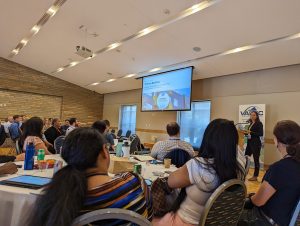 Approximately 1/3 of our greenhouse gas emissions are from the new and existing building stock. The HUB emphasizes the importance of transitioning from looking at buildings as the problem to looking at them as the opportunity. And above all, we cannot forget that buildings are for people, which is especially true when you consider that we spend roughly 90% of our lives in buildings. Therefore, they must support the community around them by focusing on energy efficiency, resiliency, and health and safety.
Approximately 1/3 of our greenhouse gas emissions are from the new and existing building stock. The HUB emphasizes the importance of transitioning from looking at buildings as the problem to looking at them as the opportunity. And above all, we cannot forget that buildings are for people, which is especially true when you consider that we spend roughly 90% of our lives in buildings. Therefore, they must support the community around them by focusing on energy efficiency, resiliency, and health and safety.
Next, John Morrill, led the business portion of the event, which started off with our 2023 Board of Directors election. VAEEC members re-elected two board members:
- Bryna Dunn, Moseley Architects (1st full term)
- Leigh Anne Ratliff, Trane Technologies (2nd term)
Members then voted to elect two new directors to the Board:
- McKenna Dunbar, Sierra Club Virginia Chapter
- Lesley Fore, Alliance to Save Energy
We are thrilled to add new voices to our leadership and to continue working with our two re-elected members. We would also like to recognize our outgoing Board members, Maggie Kelley Riggins, with the Southeast Energy Efficiency Alliance, and Joyce Bodoh, with Rappahannock Electric Cooperative, for their outstanding leadership to the organization.
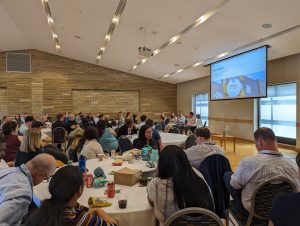 Attendees were next treated to a round robin of updates and successes from our members before moving into a networking break. After reconvening, the plenary session began. Meeting the Moment for Building Demand touched on the how the federal climate initiatives passed by the Biden administration will change the energy landscape for decades to come, before moving into how experts from across the field are planning to implement successful programs and projects using the funds. The discussion also included how we can make this round of funding more “durable” than that of the American Recovery & Reinvestment Act (ARRA) era to create systemic change and avoid the “one and done” projects.
Attendees were next treated to a round robin of updates and successes from our members before moving into a networking break. After reconvening, the plenary session began. Meeting the Moment for Building Demand touched on the how the federal climate initiatives passed by the Biden administration will change the energy landscape for decades to come, before moving into how experts from across the field are planning to implement successful programs and projects using the funds. The discussion also included how we can make this round of funding more “durable” than that of the American Recovery & Reinvestment Act (ARRA) era to create systemic change and avoid the “one and done” projects.
“We don’t have a shortage of money, but we need an easy button now to effectively deploy it. The Inflation Reduction Act is our window of opportunity to create a unified customer experience.” – Andrew Grigsby, Viridiant
Speakers included:
- Bettina Bergoo, Virginia Energy: Along with moderating the session, Bettina also spoke on Virginia Energy’s role and plans with the federal funding and the guidance currently available for HOMES/HEERHA.
- Andrew Grigsby, Viridiant: Andrew spoke on Viridiant’s success with the BENEFIT grant and how that can serve as a model for future programs. He also went into detail about the need for a unified customer experience that includes financing options available.
- Marco Rubin, Virginia Innovation Partnership Corporation: Marco discussed the startup environment since the passage of the inflation Reduction Act and Bipartisan Infrastructure Law, including looking the economic conditions at the micro-, macro-, and Marco-levels.
- Joyce Bodoh, Rappahannock Electric Cooperative: Given her role as the Director of Energy Solutions and Clean Energy at one of Virginia’s electric cooperatives, Joyce focused on how federal funding can be braided with the federal funding. She also spoke to the importance of customer data access and shared how REC’s summer savings pilot program provided $12k in bill credits to customers and saved REC $70K in wholesale power.
- Kim Strahm, Community Housing Partners: After having developed a successful workforce development program using funds from the 2009 ARRA, Kim shared best practices and lessons learned for developing and implementing programs using federal funding. Through CHP’s position on both the demand- and supply-side of high-performance buildings, Kim kept coming back to the need for a trained workforce.
As always, this event would not have been possible without our sponsors, speakers, and attendees. We would also like to thank the VAEEC Education & Events Committee for helping staff plan such a successful event.
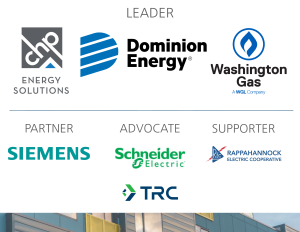 Be sure to save the date for our fall Energy Efficiency Forum– October 4th (virtual), October 5th (in-person, University of Richmond). We hope to see you there.
Be sure to save the date for our fall Energy Efficiency Forum– October 4th (virtual), October 5th (in-person, University of Richmond). We hope to see you there.
Additional event information, including speaker biographies and sponsor features, can be found in the event program. Event attendees received a PDF of the event’s presentation in the post-event email. Contact info@vaeec.org if you did not receive it. Events photos can be viewed in the photo gallery below.
The VAEEC’s 2022 Energy Efficiency Forum brought together the Commonwealth’s energy efficiency community on October 31st and November 1st. A huge thank you to our sponsors, speakers, award winners, and attendees for making this event a great success!
In order to make the event more accessible to those near and far and to provide a diverse array of speakers from across the country, day one was fully virtual. It consisted of four breakout sessions and a networking session.
A Tale of Two Heat Pumps: Heat pump adoption is a priority for the Biden administration, and the technology has long been proven to be safer and more efficient than traditional boilers. However, barriers exist to widespread use. This session discussed the barriers and opportunities with experts from the NE and SE to address these regions’ needs and perspectives. Speakers included Maggie Kelley Riggins (Southeast Energy Efficiency Alliance), Dan Lis (Northeast Energy Efficiency Partnerships), Louis O’Berry (Rappahannock Electric Cooperative), and Dan York (American Council for an Energy-Efficient Economy, moderator).
Using Less to Get More: The Role of Energy Efficiency in Decarbonization: Decarbonization has become a buzzword lately with the passage of historic federal laws. During this panel, attendees learned from those implementing successful decarbonization programs with an eye on energy efficiency. Examples included both state- and utility-run programs, including what one of the Commonwealth’s gas utilities has in the works. Erich Evans (Columbia Gas), Caterina “Katy” Hatcher (U.S. Environmental Protection Agency), Shaun Hoyte (Con Edison), and Edward Yim (ACEEE) were the speakers, while Solome Girma (D.C. Sustainable Energy Utility) moderated.
Proof of Concept: Approaches to Energy Efficiency: This case study session was designed to provide the value of shared experience and knowledge from those who have successfully navigated new technologies and programs. Robert Hart (Lawrence Berkeley National Lab) covered the advancements in window construction. Betsy Farrell Garcia and Mackenzie Stagg (Front Porch Initiative) gave an overview of rural, low-income housing programs from experts in the field. Joyce Bodoh (Rappahannock Electric Cooperative) and Brett Hood (Community Housing Partners) moderated.
Efficiency First: Strategies to Improve Municipal Buildings: Local governments and public school systems often face a unique set of challenges when it comes to the comfort, cost, and health of their buildings. This session focused on inventive ways this sector is improving its buildings through efficient and equitable programs. Speakers included Joanne Bissetta (Massachusetts Department of Energy Resources), Ann Livingston (Southeast Sustainability Directors Network), Christopher Russell (Maryland Energy Administration), and Kristel Riddervold (City of Charlottesville, VA, moderator).
Attendees gathered in person for day two at the University of Richmond Jepson Alumni Center in Richmond. The day began with an opening presentation from Executive Director, Chelsea Harnish. Attendees were updated on the organization’s 2022 accomplishments and our 2023 priorities, as well as an overview of the Commonwealth’s energy efficiency industry.
Everyone was then treated to a keynote address from Jennifer Bumgarner, the Principal Deputy Assistant Secretary, Office of Congressional and Intergovernmental Affairs at the U.S. Department of Energy (DOE). Ms. Bumgarner provided a breakdown of the Bipartisan Infrastructure Law (BIL) and Inflation Reduction Act (IRA) funding, as well as how the DOE is preparing to use this funding for the expansion of programs for state and local benefits and workforce development. Highlights of the address included approximations of when applications for the different buckets of funding will open, tips on what to include in your proposals, and DOE resources to help you navigate all of the options.
After a break of networking and snacks, attendees came back together for the plenary session, Preparing for Impact: New Funding Opportunities to Accelerate Energy Efficiency. Between the Bipartisan Infrastructure Law and the Inflation Reduction Act, states and localities are receiving a historic investment in clean energy. But what does that mean for Virginia? Experts in state and local governments, industry, and policy provided a breakdown and predictions for what’s next for energy efficiency in the Commonwealth. Speakers included Sabine Rogers (AnnDyl Policy Group), Bettina Bergoo (Virginia Energy), Abby Campbell Singer (Siemens USA), John Morrill (Fairfax County Government), and Rebecca Hui (Virginia Energy Efficiency Council, moderator).
Next, we had the privilege of hosting our seventh annual Virginia Energy Efficiency Leadership Awards ceremony. One project and two programs were recognized for their incredible energy efficiency contributions to the Commonwealth. For information on each winning project, visit our 2022 Awards page.
Finally, the event concluded with an on-site networking reception. It is always a pleasure to connect with many of our members and others in the industry face-to-face, and this was no exception.
Thank you to our sponsors, speakers, award winners, and event attendees for making this one of our best events to date. Click here to view photos of the event. Additional event information, including speaker biographies and sponsor features, can be found in the event program.
Event attendees received recordings for each of the four breakout sessions in the post-event email. Presentation PDFs can be viewed at the links above.
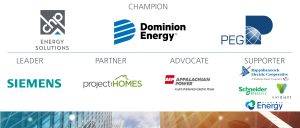
 Virginia’s High-Performance Buildings Act (HB2001) was signed into law in 2021, with the goal to drive more efficient, resilient, and future-proof buildings. The law updated the building performance standards for state/public buildings by adding electric vehicle charging and infrastructure and utility metering requirements. It also created new building performance standards for local governments.
Virginia’s High-Performance Buildings Act (HB2001) was signed into law in 2021, with the goal to drive more efficient, resilient, and future-proof buildings. The law updated the building performance standards for state/public buildings by adding electric vehicle charging and infrastructure and utility metering requirements. It also created new building performance standards for local governments.
Since the act was introduced in the General Assembly, the VAEEC and key partners have been working with the bill patron and others to clarify the requirements and identify potential updates to the existing law. This included working with the Department of General Services (DGS) to update the Virginia Energy Conservation and Environmental Standards (VEES) for the first time since 2012.
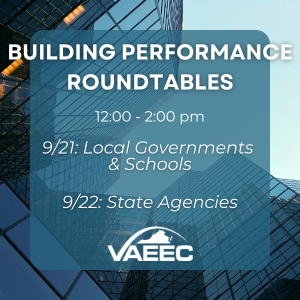 In September of this year, we held two building performance roundtable discussions with localities, state agencies, schools, architecture and design firms, engineering firms, and energy service companies. The goals were to educate stakeholders about the requirements and identify ways to update the law so that it better suits the needs of the intended audience.
In September of this year, we held two building performance roundtable discussions with localities, state agencies, schools, architecture and design firms, engineering firms, and energy service companies. The goals were to educate stakeholders about the requirements and identify ways to update the law so that it better suits the needs of the intended audience.
VAEEC Board members Elizabeth Beardsley (U.S. Green Building Council) and Bryna Dunn (Moseley Architects) started off the roundtables with an overview of the law and the pathways to compliance.
By July 1, 2021, state agency buildings were mandated to:
- Be designed, constructed, verified, and operated to comply with a high-performance building certification program,
- Comply with VEES,
- Have sufficient zero-emission vehicle infrastructure, and
- Include features that measure energy consumption and associated carbon emissions.
In the law, there is an option to exceed the above design and construction standards with prior written approval from the Director of DGS. The Director of DGS can also grant exemptions for specific projects if it is impractical to build or renovate to the standards. HB2001 also added a new reporting requirement for state agencies: an annual report is due to the Governor by January 1st detailing the energy efficiency and associated carbon emissions metrics for each applicable building built or renovated during the prior fiscal year.
Beginning July 1, 2021, buildings for localities with populations of 100,000 or more must:
- Be designed, constructed, verified, and operated to comply with one of three high-performance building certification programs (LEED certification, Green Globes Certification, or VEES verification),
- Have sufficient zero-emission vehicle charging and fueling infrastructure,
- Include features that measure the energy consumption and associated carbon emissions, and
- Incorporate appropriate resilience and distributed energy features.
Remaining localities will need to abide by these requirements beginning July 1, 2023.
Localities can seek an exemption if it is impractical to build or renovate to the standards. Local governments also have the option to adopt their own green design and construction program with standards that are more stringent than those required by law.
The above mandates apply to new buildings over 5,000 square feet and renovations where the cost of the renovation exceeds 50% of the value of the building. Smaller projects (those that are less than 20,000 gross square feet in size) have the option to achieve an ENERGY STAR certification with the implementation of mechanical, electrical, plumbing, and envelope commissioning instead.
The three compliance pathways are LEED certification, Green Globes Certification, or VEES verification. LEED v4 is the newest version of the LEED green building certification. A building must comply with a set of prerequisites, but then you can select a minimum number of criteria depending on what makes the most sense for your building. Similarly, Green Globes provides the option to pick and choose a minimum number of criteria, but this certification program does not have prerequisites. VEES follows the International Green Construction Code, so a building must comply with all of the stated requirements.
Guidance, resources, and support exist to help state agencies and local governments navigate and meet the law’s requirements. Starting October 1st, the Southeast Energy Efficiency Alliance (SEEA) will be providing technical assistance with policy creation and stakeholder engagement. They will also be providing technical assistance and training on the Building Energy Analysis Manager (BEAM) tool, which helps states and communities achieve building energy policy goals.
Additionally, Moseley Architects created a Requirements Summary for HB2001, which includes an option comparison. The U.S. Green Building Council (USGBC) curated two resources specific to green building in Virginia, Getting Started with High Performance Green Building: A Guide for Virginia Localities and VA HB2001: Summary & FAQ for Local Governments. USGBC also created Inflation Reduction Act: Buildings Provisions, which state agencies and localities will find helpful as they navigate the opportunities in the Inflation Reduction Act. These resources can be viewed at the respective links above, as well as in the VAEEC government clearinghouse. The clearinghouse also includes additional green building resources for our local government, academic, and state agency members.
Facilitated discussions took up the remainder of the event. Attendees were encouraged to ask questions and provide feedback, including:
- What part(s) of the legislation is consistent with objectives already set by your locality/agency?
- What part(s) of the legislation is helping move forward objectives that your locality/agency supports but doesn’t already have policies around?
- What clarifications or additions would you offer to update the current language?
- How can VAEEC and our partners support you in meeting your sustainability goals and the requirements of this legislation?
The presentation PDFs are available to download (local governments and schools, state agencies), and recordings of both roundtables can be viewed on the VAEEC YouTube channel. To learn more about building performance, register to attend our Energy Efficiency Forum on October 31st (virtual) and November 1st (in-person, Richmond). Additional questions can be addressed to Jessica Greene (jessica@vaeec.org).
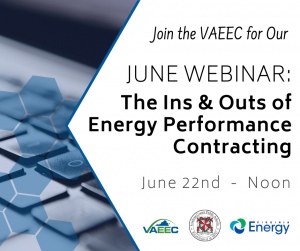 The Virginia Energy Efficiency Council (VAEEC) recently hosted a webinar, The Ins and Outs of Energy Performance Contracting, featuring Virginia Energy and Loudoun County Public Schools. The webinar provided an overview of how Energy Performance Contracting (EPC) works and the recent improvements to Virginia’s program. Loudoun County Public Schools recounted their experiences using EPC to enhance their buildings and meet their capital improvement and sustainability goals. Speakers included Nam Nguyen (Virginia Energy), Nick Polier (Virginia Energy), Michael Barancewicz (Loudoun County Public Schools), and Susan Gerson (Loudoun County Public Schools).
The Virginia Energy Efficiency Council (VAEEC) recently hosted a webinar, The Ins and Outs of Energy Performance Contracting, featuring Virginia Energy and Loudoun County Public Schools. The webinar provided an overview of how Energy Performance Contracting (EPC) works and the recent improvements to Virginia’s program. Loudoun County Public Schools recounted their experiences using EPC to enhance their buildings and meet their capital improvement and sustainability goals. Speakers included Nam Nguyen (Virginia Energy), Nick Polier (Virginia Energy), Michael Barancewicz (Loudoun County Public Schools), and Susan Gerson (Loudoun County Public Schools).
Energy Performance Contracting (EPC) is a budget-neutral option for state agencies, localities, public schools, and other public bodies to finance building upgrades while reducing energy use. Through EPC, public entities are able to improve their building performance, address maintenance needs, and reduce their energy consumption – all while achieving a guaranteed level of energy savings. Virginia’s program was established in 2002. To date, there have been more than 280 projects and over $1B in project investment.
EPC projects and customers include public K-12 schools and universities, localities, state agencies, regional jails, and correctional facilities. Virginia Energy provides support throughout the entire EPC process – from the design phase all the way through measurement and verification. This support comes at no cost to the customer and includes all necessary documents and templates to reduce time requirements. Customers are able to select an energy service company (ESCO) to perform the work from a prequalified vendor pool, which expedites the procurement process. The avoided costs from building upgrades pay for the cost of the project and there is a guaranteed energy saving.
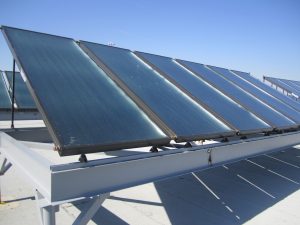 During this year’s General Assembly Session, the VAEEC worked with Virginia Energy and our ESCO members to update the Commonwealth’s existing EPC legislation. Once these laws take effect, EPC will be able to finance all roof repairs and full replacements, allowing public buildings to use EPC to become solar-ready. This will provide public bodies with the opportunity to fully finance solar under an EPC (see our fact sheet for more information).
During this year’s General Assembly Session, the VAEEC worked with Virginia Energy and our ESCO members to update the Commonwealth’s existing EPC legislation. Once these laws take effect, EPC will be able to finance all roof repairs and full replacements, allowing public buildings to use EPC to become solar-ready. This will provide public bodies with the opportunity to fully finance solar under an EPC (see our fact sheet for more information).
EPC has been particularly beneficial to some localities, such as Loudoun County, which is the fastest-growing county in Virginia with the third-largest school division. With sustainability in mind and the challenge of aging infrastructure, Loudoun County Public Schools reached a point where they could no longer reduce their energy usage without making significant investments. This led them to partner with Virginia Energy to pursue EPC. Through this first pilot project, LCPS saw a 75% kWh reduction, which was even better than the guaranteed level of energy savings. This positive experience led LCPS to continue to use EPC to not only address deferred maintenance and equipment upgrades, but to meet their capital improvement and sustainability goals.
 EPC provides the school system with the fiscal advantage of financing energy efficiency retrofits from realized future energy savings. Additional benefits include expertise in design, planning, implementation, and communication; resources that guarantee long-term success; the inclusion of non-energy conservation measures projects (such as security systems); and a trusted partnership between LCPS and their selected ESCO, CMTA. Not only did CMTA understand the nuances of working in an educational environment, but they offered staff training for LCPS employees and have participated in educational opportunities for students.
EPC provides the school system with the fiscal advantage of financing energy efficiency retrofits from realized future energy savings. Additional benefits include expertise in design, planning, implementation, and communication; resources that guarantee long-term success; the inclusion of non-energy conservation measures projects (such as security systems); and a trusted partnership between LCPS and their selected ESCO, CMTA. Not only did CMTA understand the nuances of working in an educational environment, but they offered staff training for LCPS employees and have participated in educational opportunities for students.
If you are interested in learning more about energy performance contracting, check out the resources below.
VAEEC EPC fact sheet (6/2022)
VAEEC EPC webpage
Virginia Energy EPC webpage
Webinar Presentation PDF (6/2022)
Webinar Recording link (6/2022)
The Virginia Energy Efficiency Council was excited to gather in person with Virginia’s energy efficiency industry leaders for our annual Spring Forum on May 5th. Thank you to our sponsors, speakers, and attendees for making this event a great success!
Our biannual forums are known for their ability to bring together Virginia’s energy efficiency leaders to make valuable connections, and this event did not disappoint. Energy efficiency professionals convened in person at the Dorey Recreation Center in Henrico County for ample networking time, a keynote address from a prominent energy-efficiency champion, educational presentations, a membership spotlight, and the organization’s annual business meeting with Board elections.
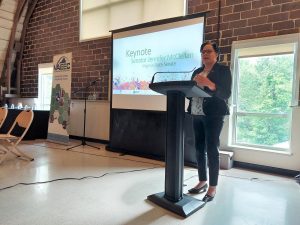
Senator Jennifer McClellan
The event kicked off with a brief opening presentation from Executive Director, Chelsea Harnish, who provided an update on the organization’s 2022 accomplishments thus far. Attendees were then treated to a keynote address from Virginia State Senator Jennifer McClellan, a long-time advocate for clean energy in the Commonwealth. Senator McClellan began by stating the importance of clean energy before specifically discussing the numerous benefits of energy efficiency; “energy efficiency is the cheapest way and the zero-carbon way to have clean energy”. She also provided a recap of recent clean energy legislation, including the Virginia Clean Economy Act and the Regional Greenhouse Gas Initiative, insisting that Virginia must continue taking action to remain a clean energy leader. We are in the midst of transiting to clean energy; Virginia can continue to be a leader, or it can be at the end of the pack.
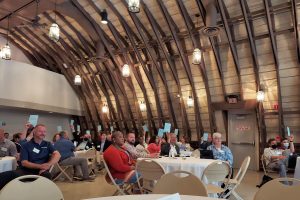
Members voting during the Board election
Next was our annual business meeting, a dedicated time where we hold our Board of Directors election and have our members share their accomplishments. Chelsea Harnish started this portion of the meeting with organizational updates, including the process of developing our 2023-2025 strategic plan. Afterward, Board Vice-Chair Mark Jackson (CHP Energy Solutions) led our 2022 Board of Directors election. VAEEC members re-elected seven Board members:
- Elizabeth Beardsley, U.S. Green Building Council
- Tim Bernadowski, Siemens Industry
- KC Bleile, Viridiant
- Bill Eger, City of Alexandria
- Stephen Evanko, Dominion Due Diligence Group
- Mark Jackson, CHP Energy Solutions, and
- Carrie Webster, Henrico County
Members elected Megan Partridge with Franklin Energy to fill an open seat on the Board of Directors. We also officially welcomed Joyce Bodoh (Rappahannock Electric Cooperative) and Bryna Dunn (Moseley Architects) to the Board. These individuals are fulfilling the terms of former Board members. We are excited to add new voices to our leadership and to continue working with our seven re-elected members.
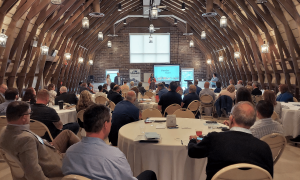
Remarkable Member Updates
After the remarkable member updates, a time for members to highlight their latest successes, and a networking break, attendees reconvened for our plenary session, Advancing Energy Efficiency in the Built Environment. Speakers included: Bryna Dunn (Moseley Architects), Andrew Grigsby (Viridiant), Abby Johnson (Virginia PACE Authority), and Benjamin Knopp (Community Housing Partners). Julia Reynolds (Chesterfield County) moderated.
While the keynote address focused on past successes and an overview of this year’s General Assembly session, this session was more forward-focused. Speakers touched on the latest and greatest opportunities for the field right now and their predictions for the next five years. They also covered the challenges and barriers, as well as the opportunities, they are seeing in their particular niche of the energy efficiency industry.
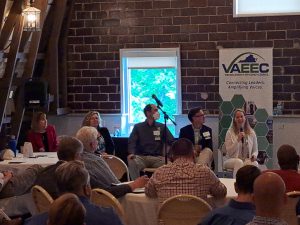
Advancing EE in the Built Environment
Abby focused on the statewide Commercial Property Assessed Clean Energy (C-PACE) program, including recent legislation that enhances the scope of C-PACE projects. Andrew emphasized the value of efficiency and green design and using funding to support social good. He also discussed the energy code work that Viridiant is doing with the Southeast Energy Efficiency Alliance. Ben talked about pushing the boundaries of weatherization with MERV-13 filtration, heat pump deployment, electrification, and weatherization deferral repairs. Bryna provided an overview of Moseley’s True Sustainability Program and how it ties together wellness, decarbonization, and resilience.
After closing remarks, the event concluded with a happy hour at Triple Crossing – Fulton in Richmond. With networking being one of the main benefits of a VAEEC membership, we were delighted to safely offer this in-person opportunity. It was a pleasure to connect with many of our members face-to-face again after primarily hosting virtual events for the past two years.
Thank you to our sponsors, speakers, and event attendees for making this one of our best events to date!
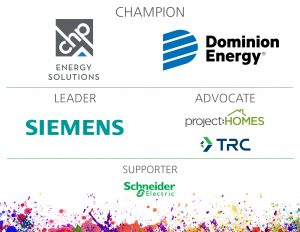
Additional event information, including speaker biographies and sponsor features, can be found in the event program. Event attendees received a PDF of the event’s presentation in the post-event email. Contact info@vaeec.org if you did not receive it. Events photos can be viewed in the photo gallery below.
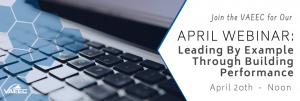 The VAEEC recently hosted a webinar on building performance primarily for local governments across the Commonwealth. Leading By Example Through Building Performance followed three different building performance policies and programs to not only encourage the audience to implement their own strong green building policy but to also provide best practices and lessons learned from the design phase all through the day-to-day management of a program.
The VAEEC recently hosted a webinar on building performance primarily for local governments across the Commonwealth. Leading By Example Through Building Performance followed three different building performance policies and programs to not only encourage the audience to implement their own strong green building policy but to also provide best practices and lessons learned from the design phase all through the day-to-day management of a program.
Speakers included:
- Dawn Oleksy, Climate Action Programs & Operations Supervisor, City of Richmond
- Bill Eger, Energy Manager, City of Alexandria
- Holly Savoia, Director of Sustainability Enforcement, NYC Department of Buildings, and
- Elizabeth Beardsley, Senior Policy Counsel, U.S. Green Building Council.
With Virginia being a Dillon Rule state, localities are limited as to what they can and cannot mandate. However, jurisdictions are finding ways to make progress happen in their communities.
The webinar began with an overview of green buildings and the benefits of a strong green building policy – such as energy savings, emission reductions, and improved air quality – from Liz. Next, Dawn covered the City of Richmond’s climate action policy, RVAgreen 2050, which the City is currently in the middle of developing. RVAgreen 2050 centers around three key points: equity, climate action, and climate resilience. Buildings & Energy is one of five pathways the City is using to meet its goal of achieving net-zero emissions by 2050 and becoming more climate-resilient. This includes requiring an equitable building performance policy for existing commercial buildings, retro-commissioning for existing commercial buildings to improve efficiency, and benchmarking existing commercial buildings.
RVAgreen 2050 is equitable climate action for a healthy and resilient Richmond.
Dawn specified the need for stakeholder engagement throughout the entire process in order to better understand the community’s priorities. She also shared RVAgreen 2050’s measuring process to track the plan’s outcomes and the shared accountability framework to encourage transparency, a culture of improvement, trusting relationships, institutionalizing sustainability in city government, and regular evaluation.
Richmond just began the next phase of community-wide engagement to gather feedback on the plan. RVAgreen 2050 is scheduled to be finalized this summer and adopted by fall.
Next, Bill provided an overview of the City of Alexandria’s Green Building Policy. The City initially enacted this policy in 2009. Alexandria created the Environmental Action Plan 2040 to support the City’s goals, which include climate action and energy reduction.
The Green Building Policy establishes minimum green building practices for new public and private development and major renovations.
To work around Virginia’s “constrained policy environment”, authority for this policy is rooted in the City’s zoning code. Certain building performance conditions are required for the Development Site Plan and Development Special Use Permit review processes. New development must achieve the LEED Silver level of certification at a minimum. Using a third-party rating system provides an expert verification of meeting compliance requirements without having to have experts on staff. The policy also includes a minimum threshold requirement for a number of community priorities, such as energy efficiency, renewable energy, and advanced energy metering.
The Green Building Policy was updated in 2019 to include newer concepts such as decarbonization. In the ten-year span between 2009 and 2019, over 95% of the development square footage constructed or currently under construction in Alexandria is compliant with the 2009 policy. This equates to nearly 10 million square feet of green building development.
Holly provided an overview of New York City’s Energy Grades Program, including the local sustainability laws that led to this program. PlaNYC set out to reduce the City’s emissions by 30% by 2030. The Greener, Greater Buildings Plan paved the way for benchmarking, energy audits and retro-commissioning, and lighting upgrades and sub-metering. Then, after Hurricane Sandy hit, the One City Built to Last Policy increased the emissions reduction goal to 40% by 2030 and 80% by 2050.
Commercial benchmarking served as the precursor to the City’s Energy Grades Program.
Since it provides transparency of a property’s annual energy and water usage, benchmarking is seen as the first step for building owners or tenants to make a building more efficient – you can’t change what you can’t measure.
The City’s commercial benchmarking mandate originally applied to buildings over 50,000 SF, but was later amended to apply to any building over 25,000 SF. Building owners must report their building’s energy and water consumption annually through the U.S. EPA’s Energy Star Portfolio Manager. Portfolio Manager is a readily accessible, free tool, so the municipality did not have to purchase it or develop their own benchmarking software. Additionally, building owners do not have to pay to use it or hire someone else to input the data, which helps lead to higher compliance rates. New York City has also created a way for building owners to automatically upload their data from their utility bills. Initially, violation fees were issued once a year. Now that they are issued on a quarterly basis, the City has a 96% compliance rate.
New York City’s Building Energy Grades Program applies to most buildings over 25,000 SF. The Department of Buildings uses a building’s benchmarking data to assign qualified buildings a letter grade distribution based on their Energy Star score. Owners are required to post their building’s Energy Efficiency Rating Label in a conspicuous location of their building’s entrance. The program provides transparency of a property’s energy efficiency to the public.
One of the key takeaways from all the speakers is the importance of getting the private sector involved early in the policy-making process. Getting them involved from the beginning not only increases buy-in but also allows localities to understand challenges that they may not have foreseen and to brainstorm solutions.
It was inspiring to see all of the thought and effort that goes into developing, implementing, and managing green building policies.
A recording of the webinar can be viewed here. Contact info@vaeec.org for more information.
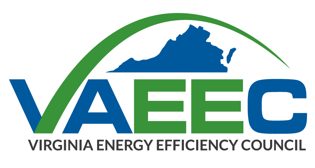


 Keynote Address:
Keynote Address:  The Energy Efficiency Workforce Initiative: A Holistic Path to Workforce Development:
The Energy Efficiency Workforce Initiative: A Holistic Path to Workforce Development: Last week, the VAEEC held our first-ever Summer Workshop, Talking Energy Efficiency to Any Audience. The idea originated through staff conversations about how do you explain energy efficiency to elementary students at a career day or to our parents when they are concerned about rising utility bills.
Last week, the VAEEC held our first-ever Summer Workshop, Talking Energy Efficiency to Any Audience. The idea originated through staff conversations about how do you explain energy efficiency to elementary students at a career day or to our parents when they are concerned about rising utility bills. Afterward, we self-selected into small groups to work with those facilitators on our own pitch. Key takeaways included:
Afterward, we self-selected into small groups to work with those facilitators on our own pitch. Key takeaways included: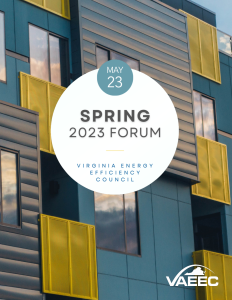
 Approximately 1/3 of our greenhouse gas emissions are from the new and existing building stock. The HUB emphasizes the importance of transitioning from looking at buildings as the problem to looking at them as the opportunity. And above all, we cannot forget that buildings are for people, which is especially true when you consider that we spend roughly 90% of our lives in buildings. Therefore, they must support the community around them by focusing on energy efficiency, resiliency, and health and safety.
Approximately 1/3 of our greenhouse gas emissions are from the new and existing building stock. The HUB emphasizes the importance of transitioning from looking at buildings as the problem to looking at them as the opportunity. And above all, we cannot forget that buildings are for people, which is especially true when you consider that we spend roughly 90% of our lives in buildings. Therefore, they must support the community around them by focusing on energy efficiency, resiliency, and health and safety. Attendees were next treated to a round robin of updates and successes from our members before moving into a networking break. After reconvening, the plenary session began. Meeting the Moment for Building Demand touched on the how the federal climate initiatives passed by the Biden administration will change the energy landscape for decades to come, before moving into how experts from across the field are planning to implement successful programs and projects using the funds. The discussion also included how we can make this round of funding more “durable” than that of the American Recovery & Reinvestment Act (ARRA) era to create systemic change and avoid the “one and done” projects.
Attendees were next treated to a round robin of updates and successes from our members before moving into a networking break. After reconvening, the plenary session began. Meeting the Moment for Building Demand touched on the how the federal climate initiatives passed by the Biden administration will change the energy landscape for decades to come, before moving into how experts from across the field are planning to implement successful programs and projects using the funds. The discussion also included how we can make this round of funding more “durable” than that of the American Recovery & Reinvestment Act (ARRA) era to create systemic change and avoid the “one and done” projects. Be sure to save the date for our fall
Be sure to save the date for our fall 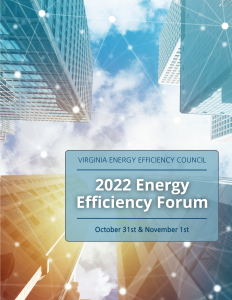

 Virginia’s
Virginia’s  In September of this year, we held two building performance roundtable discussions with localities, state agencies, schools, architecture and design firms, engineering firms, and energy service companies. The goals were to educate stakeholders about the requirements and identify ways to update the law so that it better suits the needs of the intended audience.
In September of this year, we held two building performance roundtable discussions with localities, state agencies, schools, architecture and design firms, engineering firms, and energy service companies. The goals were to educate stakeholders about the requirements and identify ways to update the law so that it better suits the needs of the intended audience.  The Virginia Energy Efficiency Council (VAEEC) recently hosted a webinar,
The Virginia Energy Efficiency Council (VAEEC) recently hosted a webinar,  During this year’s General Assembly Session, the VAEEC worked with Virginia Energy and our ESCO members to update the Commonwealth’s existing EPC legislation. Once these laws take effect, EPC will be able to finance all roof repairs and full replacements, allowing public buildings to use EPC to become solar-ready. This will provide public bodies with the opportunity to fully finance solar under an EPC (see our
During this year’s General Assembly Session, the VAEEC worked with Virginia Energy and our ESCO members to update the Commonwealth’s existing EPC legislation. Once these laws take effect, EPC will be able to finance all roof repairs and full replacements, allowing public buildings to use EPC to become solar-ready. This will provide public bodies with the opportunity to fully finance solar under an EPC (see our  EPC provides the school system with the fiscal advantage of financing energy efficiency retrofits from realized future energy savings. Additional benefits include expertise in design, planning, implementation, and communication; resources that guarantee long-term success; the inclusion of non-energy conservation measures projects (such as security systems); and a trusted partnership between LCPS and their selected ESCO, CMTA. Not only did CMTA understand the nuances of working in an educational environment, but they offered staff training for LCPS employees and have participated in educational opportunities for students.
EPC provides the school system with the fiscal advantage of financing energy efficiency retrofits from realized future energy savings. Additional benefits include expertise in design, planning, implementation, and communication; resources that guarantee long-term success; the inclusion of non-energy conservation measures projects (such as security systems); and a trusted partnership between LCPS and their selected ESCO, CMTA. Not only did CMTA understand the nuances of working in an educational environment, but they offered staff training for LCPS employees and have participated in educational opportunities for students.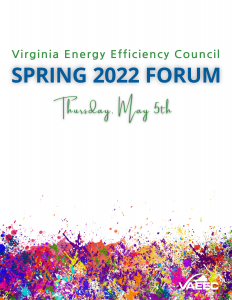





 The VAEEC recently hosted a webinar on building performance primarily for local governments across the Commonwealth. Leading By Example Through Building Performance followed three different building performance policies and programs to not only encourage the audience to implement their own strong green building policy but to also provide best practices and lessons learned from the design phase all through the day-to-day management of a program.
The VAEEC recently hosted a webinar on building performance primarily for local governments across the Commonwealth. Leading By Example Through Building Performance followed three different building performance policies and programs to not only encourage the audience to implement their own strong green building policy but to also provide best practices and lessons learned from the design phase all through the day-to-day management of a program.